Abstract
Saccharomyces cerevisiae is an important microbial organization involved in ethanol synthesis. Mutant strains that can withstand multiple pressures during this process are critical to the industrial development of biofuels. In this study, a dual high-throughput screening method of Triphenyl-2H-tetrazoliumchloride (TTC)-based macroscopic observation and the reaction of ferric nitrate with pyruvate (or pyruvate radical ion) in fermentation broth was used. Using this, an S. cerevisiae mutant library that could tolerate 381 g/L sucrose was established by ARTP random mutation and adaptive evolution to select the best strain; its ethanol yield was increased by an additional 20.48%; and the sucrose utilization rate was 81.64%. This method is specific to the selection of strains with increased ethanol production.
1. Introduction
The fossil fuel-based chemical industry is associated with serious air pollution, in part through the emission of carbon dioxide gas; the main factor affecting climate change. The traditional fossil fuel-based chemical industry with its high energy consumption and emissions is in the process of transitioning to green and low-carbon bio-manufacturing technologies [1]. Replacing fossil fuels with bio-based chemicals can achieve a “biomass-recycling-CO2-biomass” closed-loop that helps to reduce greenhouse gas emissions. Therefore, developing bio-based products from their source to achieve low-carbon economic operations is an effective tool to combat climate change. Bioethanol is widely used in the world because of its high octane number and ability to burn cleaner and cooler than regular gasoline [2]. Of the top 10 forecasts for the advanced bioeconomy by 2022 (https://www.biofuelsdigest.com/bdigest/2022/01/02/top-10-predictions-for-the-advanced-bioeconomy-in-2022/ (2 January 2022)), about half are directly or indirectly related to the alcohol industry. During the COVID-19 pandemic, the consumption of ethanol for epidemic control and medical disinfection doubled. In addition to the increasing demand for ethanol in food and medical applications, it is necessary to accelerate the research and development of bioethanol.
Ethanol synthesis by Saccharomyces cerevisiae (S. cerevisiae) is a rapid, green, and economical way to produce bioethanol [3]. However, it remains a challenge to fully utilize the characteristics of S. cerevisiae to achieve a high ethanol yield and production efficiency [4,5,6,7]. According to the “alert level” theory of yeast cell growth and fermentation factors proposed by Abbott et al. [8], changes in relevant factors of the fermentation environment beyond a certain threshold will cause negative effects. First, increasing the sugar concentration in the fermentation liquid to improve ethanol synthesis causes osmotic pressure. Second, as ethanol continuously accumulates in the fermentation environment, organic solvent stress also occurs at the late fermentation stage. Third, temperature changes in the fermentation environment cause temperature stress. Fourth, a high concentration of ions in fermentation broth causes ion stress. Fifth, reactive oxygen species in the fermentation environment result in reactive oxygen free radical accumulation that can lead to oxidative stress and other negative effects. To overcome these stresses, a series of physical, chemical, and molecular biological methods have been rapidly developed to enhance yeast robustness, including Ethidium bromide (EB) chemical treatment [9], UV-Nitroguanidine (UV-NTG) treatment [10], atmospheric room temperature plasma (ARTP) mutagenesis [11], γ-ray mutagenesis [12], protoplast fusion technology [13], adoptive evolution engineering [14], global transcription machinery engineering technology (gTME) [15] multiplex genome engineering using CRISPR/Cas9 [16], and RNAi-assisted genome evolution engineering [17]. Some S. cerevisiae mutant strains with higher ethanol synthesis ability were obtained. However, because of a lack of high-throughput screening methods that can rapidly characterize ethanol synthesis, researchers were only able to make preliminary screening using indicators that do not indicate ethanol synthesis capacity, such as growth indicators; a process that maybe inaccurate. Use of HPLC for direct measurements can also be time-consuming and intensive. Thus, it is necessary to develop a higher throughput and more accurate screening method for S. cerevisiae ethanol fermentation.
Pyruvate is a key metabolite of cell metabolism [18] that is not only involved in energy metabolism but is also a precursor of ethanol synthesis. During normal pyruvate (or pyruvic acid radical ion) metabolism, excess product is expelled from the cell. Yeast strains with high pyruvate yields have been developed [19]; measuring extracellular pyruvate (or pyruvic acid radical ion) concentration can be a more reliable gauge of ethanol synthesis. Fe3+ can react with pyruvate or pyruvic acid radical ions, but no other organic acids, to form a yellow complex ([Fe3O(CH3COCO2)6(H2O)3]+) (Supplement Figure S1) that is visible at 520 nm [20].
Thus, in this study, a dual high-throughput screening method of Tri-phenyl-2H-tetrazoliumchloride (TTC)-based macroscopic observation and the reaction of ferric nitrate with pyruvate (or pyruvate radical ion) in fermentation broth was used. The TTC-based macroscopic observation could be used for rapid initial screening. The reaction of ferric nitrate with pyruvate (or pyruvate radical ion) in fermentation broth was inversely related to the ethanol synthesis ability of the S. cerevisiae derived strains; there was a strong linear relationship at OD520 nm (Py-Fe3+ method). This method is specific to the selection of strains with increased ethanol production.
2. Materials and Methods
2.1. Strain and Medium
S. cerevisiae strain GJ2008 (MATa; his3Δ1; leu2Δ0; met15Δ0; ura3Δ0) was used as the original strain in this study. S. cerevisiae GJ2009, GJ2010, GJ2011, GJ2012, and NT-F1 were derived from GJ2008 by ARTP mutagenesis with different ethanol synthesis capacities. The YPD medium (10 g/L yeast extract, 20 g/L peptone, and 310 g/L sucrose) was used for cell growth.
2.2. ARTP-Based Random Mutagenesis and Adaptive Evolution
A 5 mL cell broth cultured for about 12 h was harvested by centrifugation and washed twice with ice-cold water. Then, atmospheric and room temperature plasma (ARTP) mutagenesis was carried out using an ARTP mutation system (ARTP-C2-5, Tmaxtree Biotechnology Co., Ltd., Wuxi, China) as described by Niu et al. [21]. The parameters were set as follows: (1) the radio frequency power input was set at 100 w, the flow of helium was set at 10 SLM; (2) the distance between the plasma torch nozzle exit and the slide was set at 2 mm; (3) the different treatment times were selected as 80, 100, 120, 140, 160, 180 and 200 s. After treatment, slides were washed with ice-cold water to generate the ARTP mutant library. The mutant strains were transferred to 10 mL YPD medium with 286 g/L sucrose and cultivated at 30 °C and 200 rpm for 24 h. The number of cells was measured with a blood counting plate until the number of cells stabilized, then ARTP mutagenesis was performed again and the passage was gradually increased to higher concentrations (286, 310, 333, 357 and 381 g/L sucrose).
2.3. TTC-Based Screening
A library of S. cerevisiae submitted to ARTP mutagenesis that could grow on 381 g/L of sucrose was diluted with sterile water and then coated on a solid medium containing 381 g/L sucrose. 24 h later, about 20 mL Triphenyl-2H-tetrazoliumchloride (TTC) solution was introduced to react for 5 min and the yeast strains with the earliest red and darkest color were selected (5 g/L glucose was prepared for sterilization and 0.5 g/L TTC was added when it was cooled to 55 °C). The selected S. cerevisiae colonies were then placed on new plates for growth before the next experiment.
2.4. Py-Fe3+-Based Screening
Single S. cerevisiae colonies on the slant plates were transferred to 48-deep-well microtiter plates (DWMP) containing 1 mL YPD with 381 g/L sucrose and cultivated with 30 °C and 200 rpm for 72 h. After the fermentation, DWMPs were left to rest for 30 min to allow S. cerevisiae strains to sink automatically. The fermentation broth was used for determination. Yeast cells were removed either by standing or by brief centrifugation. The next reaction system was configured as described by Luo et al. [19]. Then, 120 µL of the fermentation supernatant (five times dilution) was transferred to a 96-well enzyme label plate and 80 µL 1 M Fe(NO3)3 was added for reaction at room temperature for 10 min. Then, the absorbance was measured at OD520 nm. Finally, several strains with low OD520 values were selected for subsequent shake-flask fermentation and re-screening.
2.5. Shake-Flask Fermentation
Colonies from YPD plates were used to inoculate the YPD medium and incubated overnight with shaking at 30 °C and 200 rpm. The overnight seed solution was transferred at 10% inoculum to a new YPD medium containing 310 g/L sucrose (each plate was sealed with plastic film and kraft paper to prevent ethanol volatilization). The cultures were incubated at 30 °C and 150 rpm for 36 h.
2.6. GC Analysis and Cell Growth Assay
Culture turbidity was monitored at 600 nm and the number of cells was measured with a blood counting plate. Ethanol production was analyzed by GC-FID (Techcomp Scion 456-GC, Shanghai, China). The inlet temperature was set to 200 °C with the flow at 1 mL/min and the oven at 40 °C for 0 s, 40–80 °C for 5 min, and 80–150 °C for 10 min.
2.7. Statistical Analysis
All experiments were conducted in triplicate and the data were averaged and presented as the means ± standard deviation. The OriginPro (version 9.0) was used for data processing.
3. Results and Discussion
3.1. The Feasibility of Using Py-Fe3+ to Identify High-Titer Ethanol Production
While the determination of ethanol concentration using GC is highly accurate, it is cumbersome, time-consuming, and not always suitable for high-throughput screening. In addition, pyruvate testing kits are expensive and the pyruvic acid radical ion is difficult to measure. Thus, establishing a cheap, efficient screening method is critical. S. cerevisiae uses carbon metabolism to synthesize pyruvate, which reacts with pyruvate decarboxylase to form acetaldehyde, which then reacts with ethanol dehydrogenase to form ethanol (Figure 1). Ferric nitrate can react with the pyruvate or pyruvic acid radical ion, but no other organic acids, to form a yellow complex [20]. To characterize the reaction relationship in more detail, 120 µL pyruvate standard at different concentrations was added to 80 µL ferric nitrate (1 M). There was a linear relationship between different pyruvate concentrations and the OD520 (Figure 2). A strong linear relationship of R2 = 0.996 was demonstrated, ensuring the accuracy of data filtering.
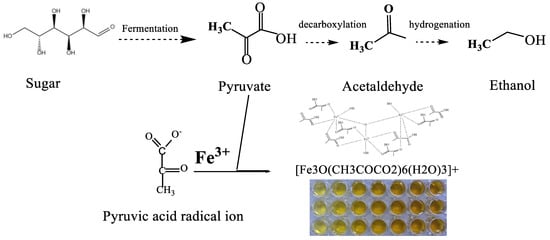
Figure 1.
Schematic diagram of Py-Fe3+ high-throughput screening principle. Ferric nitrate can react with the pyruvate or pyruvic acid radical ion, but no other organic acids, to form a yellow complex.
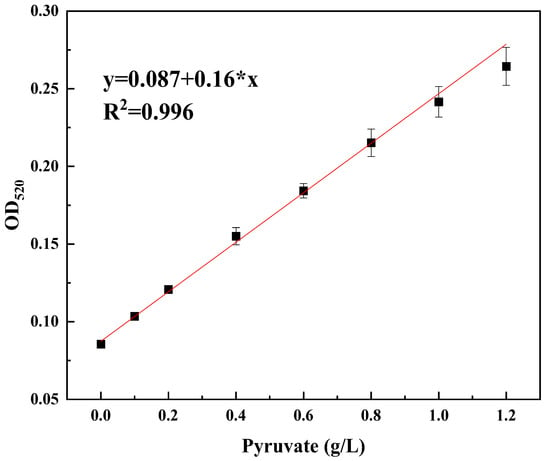
Figure 2.
The linear relationship between different pyruvate concentrations and the OD520 (* Code multiplier).
Four S. cerevisiae strains, GJ2009, GJ2010, GJ2011, and GJ2012 (derived from GJ2008 by ARTP mutagenesis (data not shown)), with different ethanol synthesis capacities, were verified by fermentation under 190 g/L sucrose after 30 h (Figure 3). While the ethanol yield of GJ2010, GJ2012, GJ2011, and GJ2009 increased successively, the OD520 value of fermentation broth measured using the Py-Fe3+ method decreased successively. The real-time detection from the ethanol synthesis curve was shown in Supplement Figure S2. More research is needed to reveal the mechanism. Thus, the ethanol synthesis ability of S. cerevisiae-derived strains was inversely proportional to the concentration of pyruvate (or pyruvate radical ions) in the fermentation broth. Pyruvate is one of the important precursors in microorganisms. The amount of pyruvate synthesized by microorganisms and its utilization rate will largely determine the growth and performance of cells. Therefore, we speculated that the pyruvate content produced by S. cerevisiae cells of the same derivative strain at the same period was comparable, but the yeast strain with stronger metabolic transformation ability would accelerate its utilization. Therefore, it was concluded that the amount of ethanol synthesis in the paper was inversely proportional to the pyruvate (or pyruvate radical ions) content in the fermentation broth. Moreover, as can be seen in Figure 3, with the increase of ethanol content the OD520 value did not significantly decrease, which may be the result of the increase of the volume of the yeast. Genomic resequencing and comparative transcriptomic analysis may be ideal means to reveal the results of this experiment, which will be published in a subsequent paper.
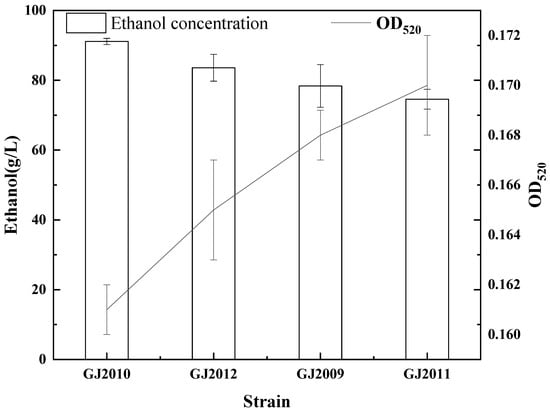
Figure 3.
(☐ Ethanol concentration) Four S. cerevisiae strains, GJ2009, GJ2010, GJ2011, and GJ2012 (derived from GJ2008), with different ethanol synthesis capacities, were verified by fermentation under 190 g/L sucrose after 30 h. (-OD520) 120 µL of these four S. cerevisiae strains’ fermentation supernatant (five times dilution) was transferred to a 96-well enzyme label plate and 80 µL 1M Fe(NO3)3 was added for reaction at room temperature for 10 min. Then the absorbance was measured at OD520 nm.
3.2. Tolerance Engineering Improves Tolerance to High Sucrose Levels
Increasing the sugar concentration in fermentation broth is a direct way to increase ethanol production. However, high sugar concentrations cause increased osmotic pressure and stress cell growth and vitality which in turn leads to a further decrease in yield. Thus, ARTP mutagenesis and adaptive evolution are used to improve the robustness of S. cerevisiae in the presence of high concentration sucrose. To find an appropriate inhibitory concentration of sucrose for the initiation of mutagenesis, we first tested the effect of different sucrose concentrations on the growth of Saccharomyces cerevisiae GJ2008 (Figure 4) and found that S. cerevisiae cell numbers peaked at 238 g/L sucrose. Thus, after ARTP mutagenesis, the mutant yeast library was cultured and subcultured in a 286 g/L sucrose fermentation medium. After stable growth was achieved, another round of mutagenesis was carried out at a sucrose concentration of 381 g/L (Supplement Figure S3). The cell morphology also changed from a state of initial inhibition (Supplement Figure S4A; cells were shriveled and sticky) to a state of release (Supplement Figure S4B; cells were scattered and plump), which may be the reason for improved tolerance and increased yield.
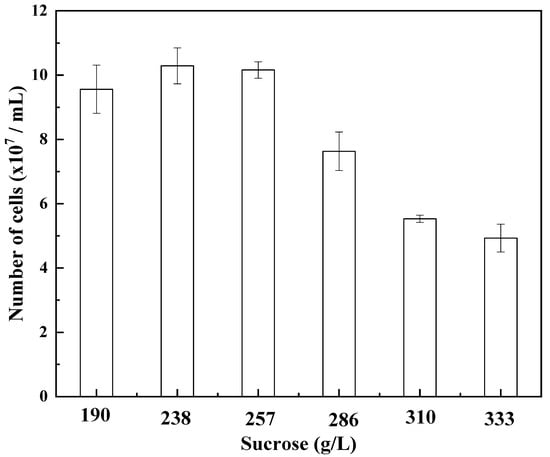
Figure 4.
Effects of sucrose concentration on the growth of S. cerevisiae GJ2008.
3.3. Isolation of Mutant Strains by TTC and Py-Fe3+
Triphenyl-2H-tetrazoliumchloride (TTC) reacts with yeast metabolites and is reduced by hydrogen into insoluble red tribenzoate (TTF) [22], which is a measure of cell vitality. Mutant yeast cells that could tolerate 381 g/L sucrose were diluted on the coating plate, TTC solution was added for initial screening, and 380 strains with the first and deepest reddening were selected for subsequent screening using the Py-Fe3+ method.
The 380 mutant strains were selected and cultured on 48-well plates. Fermentation broth supernatant (120 µL) and 80 µL ferric nitrate (1 M) were reacted at room temperature for 10 min and OD520 measurements were performed. A small number of strains had a significantly lower OD520 value in the fermentation broth (Figure 5). The six strains (Shown by arrows in Figure 5) with the lowest OD520 value were selected for shaking and the dominant NT-F1 strain with the highest ethanol synthesis was obtained (Supplement Table S1). To verify the feasibility of this method, two OD520 strains (NT-FX and NT-FY) with higher values were randomly selected for fermentation from the 380 strains, but their ethanol yield remained at about 80 g/L (Supplement Figure S5). The results illustrated that it is not accurate to rely solely on respiratory intensity as a screening mechanism and a more accurate screening method is necessary.
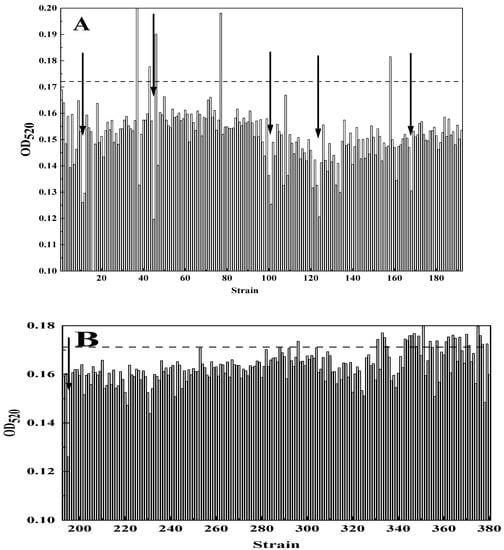
Figure 5.
Isolation of mutant strains by Py-Fe3+. (A,B) The 380 mutant strains were selected and cultured on 48-well plates. Fermentation broth supernatant (120 µL) and 80 µL ferric nitrate (1 M) were reacted at room temperature for 10 min and OD520 measurements were performed. (----) The dashed line represents the OD520 value of S. cerevisiae GJ2008 fermentation under the same conditions(The arrows indicate the selected strains).
3.4. Comparison of Ethanol Fermentation Capacity and Growth Capacity of Mutant and Non-Mutant Strains
Sucrose fermentation media of 286, 310, 333, 357, and 381 g/L were used to determine the conditions for optimal ethanol production (Figure 6). In media with a 310 g/L sucrose concentration, the ethanol yield by the mutant strain of NT-F1 reached 135.58 g/L (17.18% (vol)) and the production efficiency was 81.64%. The ethanol yield of the parent strain GJ2008 reached the highest at 286 g/L sucrose concentration, which was only 112.55 g/L (the production efficiency was only 70.25%) (Figure 7). The ethanol yield of NT-F1 was 20.48% higher than that of parent strain GJ2008. In addition, the mutant strain NT-F1 had a higher growth performance in a high-sugar environment than the parent strain GJ2008 (Figure 8). This may explain the increase in ethanol production.

Figure 6.
Optimization of sucrose ethanol synthesis by mutant strain. Sucrose fermentation media of 286, 310, 333, 357, and 381 g/L were used to determine the conditions for optimal ethanol production.
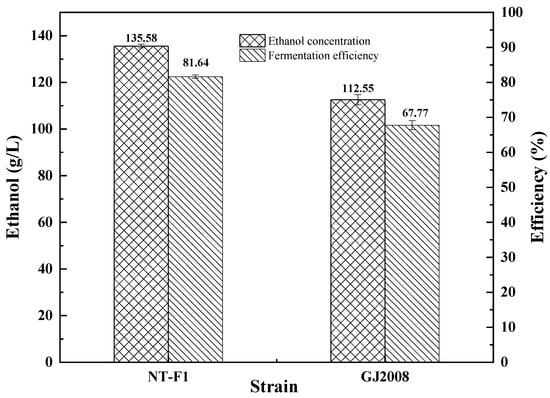
Figure 7.
Comparison of ethanol fermentation capacity of mutant and non-mutant strain. The mutant strain NT-F1 compared with non-mutant strain GJ2008 under 310 g/L sucrose.
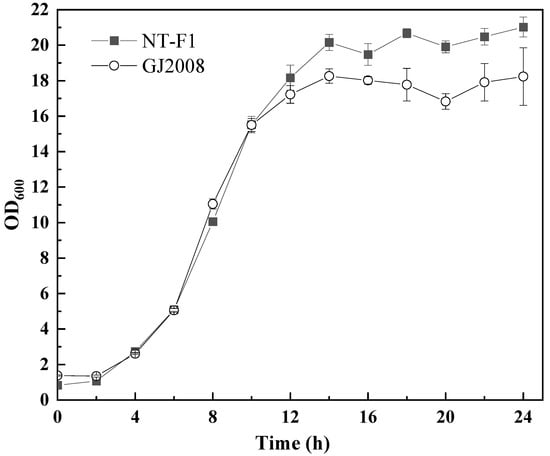
Figure 8.
Comparison of growth capacity of mutant and non-mutant strain. The mutant strain NT-F1 compared with non-mutant strain GJ2008 under 310 g/L sucrose.
4. Conclusions
This study established and implemented a new screening strategy for S. cerevisiae mutagenesis. The yellow substance formed by the reaction of ferric nitrate with pyruvate (or pyruvic acid radical ions) in the fermentation medium had a strong linear relationship at OD520. The ethanol fermentation capacity of the derived yeast from the same S. cerevisiae was inversely proportional to the concentration of pyruvate (or pyruvate radical ions) in the fermentation broth. By establishing a high-throughput Py-Fe3+ screening method, mutant S. cerevisiae strains with a high sugar tolerance were selected. The ethanol yield of evolved S. cerevisiae NT-F1 reached 135.58 g/L (17.18% (vol)) and the production efficiency reached 81.64%, which was 20.46% higher than that of the non-mutant strain (GJ2008). While the mutant strain had an improved rate of sugar utilization and ability to withstand a high osmotic pressure environment, organic solvent (ethanol), temperature, oxidativion, and other stresses were also involved in the ethanol fermentation process. The design of new methods that are able to effectively remove these stresses from S. cerevisiae cultures is needed. While it is difficult to separate and measure the amount of pyruvate or pyruvic acid radical ions that react with ferric nitrate in this study, the established method and its application will effectively promote high-precision screening of S. cerevisiae culture and promote the efficiency of ethanol synthesis.
Supplementary Materials
The following supporting information can be downloaded at: https://www.mdpi.com/article/10.3390/pr10112186/s1, Figure S1: Structure of [Fe3O(CH3COCO2)6(H2O)3]+ [23]; Figure S2: (A) Four S. cerevisiae strains, GJ2009, GJ2010, GJ2011, and GJ2012 (derived from GJ2008) with different ethanol synthesis capacities, were verified by fermentation under 190 g/L sucrose. (B) 120 µL of these four S. cerevisiae strains’ fermentation supernatant (Five times dilution) was transferred to a 96-well enzyme label plate, and 80 µL 1M Fe(NO3)3 was added for reaction at room temperature for 10 min. Then the absorbance was measured at OD520 nm; Figure S3: ARTP mutation and adaptive evolution; Figure S4 Comparison of cell morphology between mutant bacteria and non-mutant bacteria at sucrose concentration of 381 g/L after 24 h; Figure S5 Ethanol production of the selected mutants with higher OD520; Table S1 Optimum strain fermentation and screening.
Author Contributions
W.-Y.W. performed all the experimental works. S.-H.W. revised the paper. Y.-H.X., M.Z., M.-L.W. and Z.-Y.L. performed the ethanol assay. X.-F.L. and F.-X.N. designed the study and wrote the manuscript. All authors have read and agreed to the published version of the manuscript.
Funding
This work was funded by the central government guides the special fund for local science and technology development (No. ZY22096007), Guangxi Natural Science Foundation (No. AD19110052), Guangxi Innovation-driven Development Special Fund Project (No. AA20302019-5), the National Natural Science Foundation of China (Grant No. 32260246), Guangxi Science and technology base and talents special project (No. AD22080011), the Opening Project of Guangxi Key Laboratory of Green Processing of Sugar Resources (N0. GXTZY202003), and the doctoral fund of Guangxi university of science and technology (No. 21Z50).
Institutional Review Board Statement
Not applicable.
Informed Consent Statement
Not applicable.
Data Availability Statement
Not applicable.
Conflicts of Interest
The authors declare that the research was conducted in the absence of any commercial or financial relationships that could be construed as a potential conflict of interest.
Competing Interests
The authors declare that they have no competing interest.
Consent for Publication
Not applicable.
Availability of Data and Materials
Not applicable.
Ethics Approval and Consent to Participate
Not applicable.
References
- Bautista, K.; Unpaprom, Y.; Junluthin, P.; Ramaraj, R. Ethanol production from corn stalk juice by Saccharomyces cerevisiae immobilized yeast using a green method. Biomass Convers. Biorefin. 2022, 1–8. [Google Scholar] [CrossRef]
- Almeida, I.C.; Pacheco, T.F.; Machado, F.; Gonalves, S.B. Evaluation of different strains of Saccharomyces cerevisiaefor ethanol production from high-amylopectin BRS AG rice (Oryza sativa L.). Sci. Rep. 2022, 12, 2122. [Google Scholar] [CrossRef] [PubMed]
- Wang, L.; Li, B.; Su, R.R.; Wang, S.P.; Xia, Z.Y.; Xie, C.Y.; Tang, Y.Q. Screening novel genes by a comprehensive strategy to construct multiple stress-tolerant industrial Saccharomyces cerevisiae with prominent bioethanol production. Biotechnol. Biofuels Bioprod. 2022, 15, 11. [Google Scholar] [CrossRef] [PubMed]
- Qian, L.; Zhao, X.Q.; Chang, A.K.; Zhang, Q.M.; Bai, F.W. Ethanol-induced yeast flocculation directed by the promoter of TPS1 encoding trehalose-6-phosphate synthase 1 for efficient ethanol production. Metab. Eng. 2012, 14, 1–8. [Google Scholar] [CrossRef]
- Qin, L.; Zhao, X.; Li, W.C.; Zhu, J.Q.; Liu, L.; Li, B.Z.; Yuan, Y.J. Process analysis and optimization of simultaneous saccharification and co-fermentation of ethylenediamine-pretreated corn stover for ethanol production. Biotechnol. Biofuels 2018, 11, 118. [Google Scholar] [CrossRef]
- Qin, L.; Dong, S.; Yu, J.; Ning, X.; Xu, K.; Zhang, S.-J.; Xu, L.; Li, B.-Z.; Li, J.; Yuan, Y.-J.; et al. Stress-driven dynamic regulation of multiple tolerance genes improves robustness and productive capacity of Saccharomyces cerevisiae in industrial lignocellulose fermentation. Metab. Eng. 2020, 61, 160–170. [Google Scholar] [CrossRef]
- Ye, P.-L.; Wang, X.-Q.; Yuan, B.; Liu, C.-G.; Zhao, X.-Q. Manipulating cell flocculation-associated protein kinases in Saccharomyces cerevisiae enables improved stress tolerance and efficient cellulosic ethanol production. Bioresour. Technol. 2022, 348, 126758. [Google Scholar] [CrossRef]
- Abbott, D.A.; Ingledew, W.M. Buffering capacity of whole corn mash alters concentrations of organic acids required to inhibit growth of Saccharomyces cerevisiae and ethanol production. Biotechnol. Lett. 2004, 26, 1313–1316. [Google Scholar] [CrossRef]
- Elhussieny, N.I.; Bakri, M.M.; Ganash, M.; Ghany, T. Chemical mutagenesis of Saccharomyces cerevisiae for enhancing bioethanol production with ffermentation at very High sugar concentration. Bioresources 2020, 15, 1354–1369. [Google Scholar] [CrossRef]
- Shen, N.; Wang, Q.; Qin, Y.; Wang, C.; Liao, S.; Zhu, J.; Huang, R. Breeding of a thermotolerant and high ethanol-producing Saccharomyces cerevisiae strain by uv-ntg composite protoplast mutagenesis. Liquor-Making. Sci. Technol. 2011, 5, 23–26. [Google Scholar] [CrossRef]
- Wang, L.; Li, B.; Wang, S.-P.; Xia, Z.-Y.; Gou, M.; Tang, Y.-Q. Improving multiple stress-tolerance of a flocculating industrial Saccharomyces cerevisiae strain by random mutagenesis and hybridization. Process Biochem. 2021, 102, 275–285. [Google Scholar] [CrossRef]
- Arshad, M.; Hussain, T.; Chaudhry, N.; Sadia, H.; Aslam, B.; Tahir, U.; Abbas, M.; Qureshi, N.; Nazir, A.; Rajoka, M.I. Enhancing profitability of ethanol fermentation through gamma ray mutagenesis of Saccharomyces cerevisiae. Pol. J. Environ. Stud. 2019, 28, 35–41. [Google Scholar] [CrossRef]
- Shi, D.J.; Wang, C.L.; Wang, K.M. Genome shuffling to improve thermotolerance, ethanol tolerance and ethanol productivity of Saccharomyces cerevisiae. J. Ind. Microbiol. Biotechnol. 2009, 36, 139–147. [Google Scholar] [CrossRef] [PubMed]
- Li, W.-C.; Zhu, J.-Q.; Zhao, X.; Qin, L.; Xu, T.; Zhou, X.; Li, X.; Li, B.-Z.; Yuan, Y.-J. Improving co-fermentation of glucose and xylose by adaptive evolution of engineering xylose-fermenting Saccharomyces cerevisiae and different fermentation strategies. Renew. Energy 2019, 139, 1176–1183. [Google Scholar] [CrossRef]
- Alper, H.; Moxley, J.; Nevoigt, E.; Fink, G.; Stephanopoulos, G. Engineering yeast transcription machinery for improved ethanol tolerance and production. Science 2006, 314, 1565–1568. [Google Scholar] [CrossRef]
- Liu, K.; Yuan, X.; Liang, L.; Fang, J.; Chen, Y.; He, W.; Xue, T. Using CRISPR/Cas9 for multiplex genome engineering to optimize the ethanol metabolic pathway in Saccharomyces cerevisiae. Biochem. Eng. J. 2019, 145, 120–126. [Google Scholar] [CrossRef]
- HamediRad, M.; Lian, J.; Li, H.; Zhao, H. RNAi assisted genome evolution unveils yeast mutants with improved xylose utilization. Biotechnol. Bioeng. 2018, 115, 1552–1560. [Google Scholar] [CrossRef]
- Ping, X.; Qiu, J.; Chao, G.; Ma, C. Biotechnological routes to pyruvate production. J. Biosci. Bioeng. 2008, 105, 169–175. [Google Scholar] [CrossRef]
- Luo, Z.; Zeng, W.; Du, G.; Song, L.; Jian, C. A high-throughput screening procedure for enhancing pyruvate production in Candida glabrata by random mutagenesis. Bioprocess Biosyst. Eng. 2017, 40, 1–9. [Google Scholar] [CrossRef]
- Hu, X.; Lin, B.; Yang, S. Comparison between several chemical detection methods of pyruvate production in fermentation. Cereals. Oils Process 2010, 12, 165–168. [Google Scholar]
- Niu, F.-X.; He, X.; Wu, Y.-Q.; Liu, J.-Z. Enhancing production of pinene in Escherichia coli by using a combination of tolerance, evolution, and modular co-culture engineering. Front. Microbiol. 2018, 9, 1623. [Google Scholar] [CrossRef]
- Zhang, M.; Zhu, R.; Zhang, M.; Wang, S. Creation of an ethanol-tolerant Saccharomyces cerevisiae strain by 266 nm laser radiation and repetitive cultivation. J. Biosci. Bioeng. 2014, 118, 508–513. [Google Scholar] [CrossRef]
- Mehrotra, R.-N.; Hasan, T. Detection and spectrophotometric determination of pyruvic acid. Anal. Lett. 1986, 19, 1713–1724. [Google Scholar] [CrossRef]
Publisher’s Note: MDPI stays neutral with regard to jurisdictional claims in published maps and institutional affiliations. |
© 2022 by the authors. Licensee MDPI, Basel, Switzerland. This article is an open access article distributed under the terms and conditions of the Creative Commons Attribution (CC BY) license (https://creativecommons.org/licenses/by/4.0/).